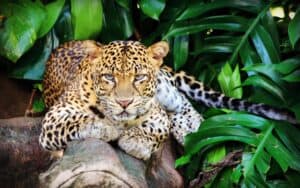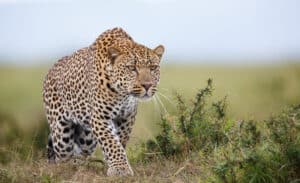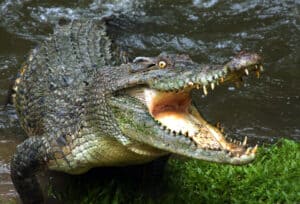Rare and highly elusive, both the clouded leopard and the snow leopard are solitary cats that are rarely seen. They possess striking physical features, piercing eyes, and threatening canines capable of tearing flesh apart with ease. These are two of the ten largest cats in the world. They share the IUCN red list status of vulnerable to extinction.
Less than 7,000 mature adults of each species remain and populations continue to decline. Habitat devastation due to deforestation and illegal poaching contribute to the rare sight of these awe-inspiring creatures becoming even rarer. While these spotted cats share many features in common they are actually quite different from one another. In this article, we’ll outline all the differences separating the clouded leopard vs the snow leopard.
Comparison: Clouded Leopard vs Snow Leopard
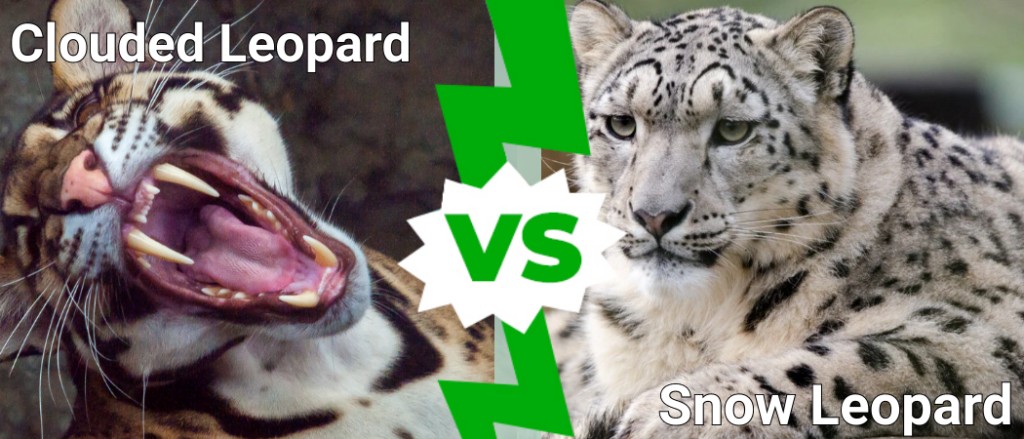
| Common Name | Clouded Leopard | Snow Leopard |
| Scientific Name | Neofelis nebulosa | Panthera uncia |
| Size | 25-51 lbs | 49-155 lbs |
| Habitat | Arboreal, Forests | Alpine & Subalpine Mountains |
| Activity | Nocturnal | Crepuscular |
Classification of These Big Cats
The clouded leopard and the snow leopard share the same family of Felidae, commonly known as cats. Some features they share are retractile claws, slender and muscular bodies, and strong, flexible forelimbs. They are obligate carnivores, or true carnivores, depending solely on other animals to meet their nutritional requirements. Most are solitary predators who ambush or stalk their prey. They clamp down with a powerful bite due to the structure of their teeth and facial muscles.
These cats belong to the same subfamily of Pantherinae, but from there they diverged. The clouded leopard is part of the genus Neofelis and its species name is N. nebulosa. The snow leopard is part of to the Panthera genus and its species name is P. unicia.
The Primary Differences Between Clouded Leopards and Snow Leopards
The differences between snow leopards and clouded leopards include size, habitat, and physical characteristics. Snow leopards are generally larger and live in alpine environments while clouded leopards live in dense forests. In addition, clouded leopards have unique teeth that make them “modern-day sabretooth cats.” Let’s dive into the primary differences between these two big cats in detail.
Habitat: Clouded Leopard vs Snow Leopard
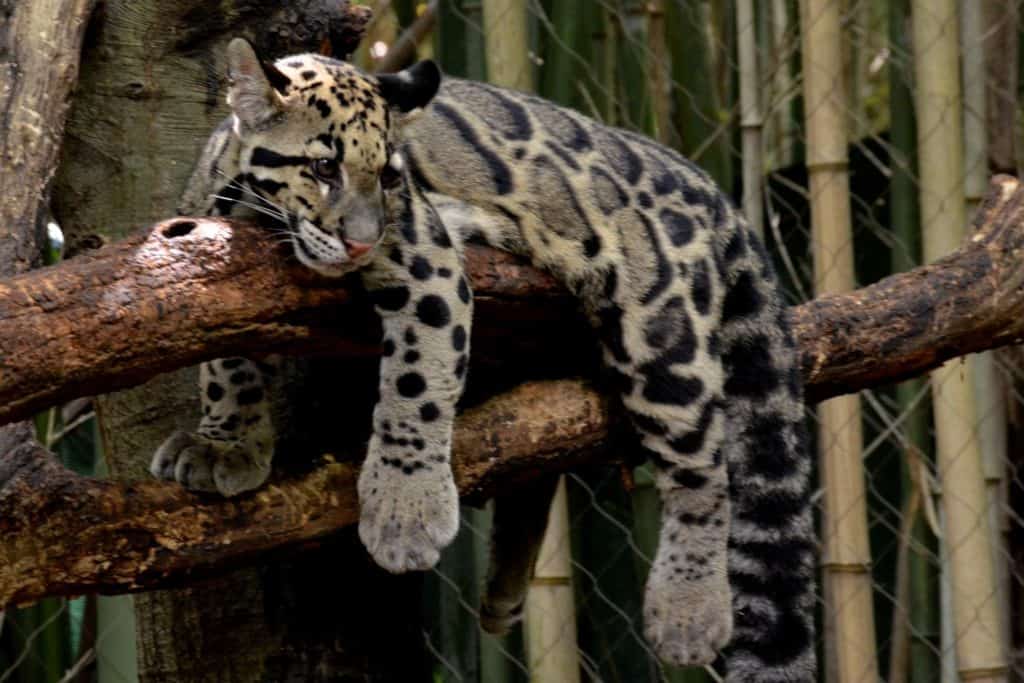
Clouded leopards live in dense primary forests, while the rough and rugged mountains are home to the snow leopard.
The clouded leopard finds home from the Himalayan foothills in Nepal, Bhutan and India through Myanmar, southeastern Bangladesh, Thailand, Malaysia and into southern China. It is now extinct in Singapore and Taiwan. As tree dwellers, they prefer dense primary forests, especially evergreen tropical rainforests. But, they also sometimes occupy dry and deciduous forests, shrubland, and grasslands.
The snow leopards range stretches from eastern Afghanistan, the Himalayas, and the Tibetan Plateau to southern Siberia, Mongolia, and western China. Snow leopards occupy alpine and subalpine zones. They like to take rests near cliffs and mountainous ridges for shade and a good vantage point and have earned their nickname “ghost of the mountains.” They prefer steep, rugged, and broken terrain and rocky outcrops, but also inhabit forests and relatively flat, rolling areas.
Physical Characteristics: Clouded Leopard vs Snow Leopard

A “modern-day sabre tooth” the clouded leopard has very large canines, as “ghost of the mountains” the snow leopards canines are long and slender
©Chris Desborough/Shutterstock.com
The clouded leopard is likely named for its large dusky-gray, irregular spots and stripes, reminiscent of a cloudy sky. Their tail is marked by large and irregular paired spots. The clouded leopard has the largest canines of any cat in proportion to their body size, giving them the nickname “modern-day sabre tooth.” Their canines are 1.6 inches on average and these cats weigh 25-51 lbs.
The snow leopard has whitish to gray fur with black spots on its head and neck. These turn to larger rosettes from back to tail. They have big bushy tails that are thick due to fat storage. Because their tails have thick fur, they can use them like a blanket to protect their face while they sleep. The snow leopard is a larger feline at 49-155 lbs, with the occasional male reaching up to 165 lbs. Their canines are 1.13 inches long on average and are more slender than those of other Pantheras.
Adaptations: Clouded Leopard vs Snow Leopard

Neither the clouded leopard or the snow leopard can roar, instead they meow, prusten and express themselves with other hisses, grunts and moans.
©Various images/Shutterstock.com
Clouded leopards are an arboreal species that has adapted to become an exceptional tree climber, one of the most talented among all cats. In captivity, they’ve been witnessed climbing down vertical tree trunks headfirst. They can hang on branches with their hind paw and are capable of supination, a rotation of their paw which makes this movement possible. Climbing along horizontal branches with their backs to the ground, they can even make short jumps forward in this position. Their throat structure prevents them from being able to roar. Instead, clouded leopards vocalize with high-pitched meows, loud crying calls, they prusten (breathy snort) and raise their muzzle in greeting. They warn with a low-pitched growl and hiss with exposed teeth.
The snow leopard possesses a range of adaptations for surviving in the extremes of cold weather. They have large nasal cavities for increasing their air intake upon inhale and warming and humidifying cool air. Their small, rounded ears minimize heat loss. Also, broad paws let them distribute their body weight for walking on snow. The fur on their paw undersides helps increase grip on slippery or icy terrain. Like the clouded leopard, they cannot roar but speak by meowing, grunting, and by prusten, purring and moaning.
Pretty Predators on the Prowl

Clouded leopards are solitary and nocturnal, while snow leopards are crepuscular they also prefer to keep to themselves
©abzerit/Shutterstock.com
The clouded leopard is a secretive, arboreal and nocturnal species that rests in trees by day and hunts the forest floor at night. While they are most active at night, they’ve also shown crepuscular activity peaks. They stalk their prey and wait for them to approach. Both terrestrial and arboreal prey are enjoyed, depending on what’s available. They’ve been seen with pig-tailed macaques, Indian hog deer, barking deer, Bengal slow loris and Asiatic brush-tailed porcupine. They also enjoy pheasants and ground squirrels.
Crepuscular cats, snow leopards are most active at dawn until early morning, again in afternoons and early evenings, although they also sometimes roam about at night. They have evolved to eat large-bodied mountainous prey and to hunt them successfully in harsh and resource-limited terrains. A meta-analysis done to determine the primary prey of the snow leopard for conservation purposes found that they prefer Himalayan blue sheep (ghazal), tahr, and Siberian ibex. They also consume markhor, boar, deer and marmots.
The photo featured at the top of this post is © Abeselom Zerit/Shutterstock.com
Thank you for reading! Have some feedback for us? Contact the AZ Animals editorial team.



